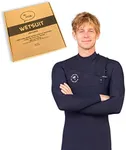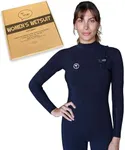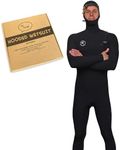Buying Guide for the Best Wetsuits
Choosing the right wetsuit is crucial for ensuring comfort, warmth, and flexibility while engaging in water activities. The right wetsuit will depend on the water temperature, the type of activity you are doing, and your personal preferences. Understanding the key specifications will help you make an informed decision and find the best wetsuit for your needs.ThicknessThickness refers to the thickness of the neoprene material used in the wetsuit, usually measured in millimeters. This spec is important because it determines the warmth and flexibility of the wetsuit. Thicker wetsuits (5mm or more) provide more insulation and are suitable for colder waters, but they can be less flexible. Thinner wetsuits (2mm or less) offer greater flexibility and are ideal for warmer waters. For moderate temperatures, a wetsuit with a thickness of 3mm to 4mm is a good balance. Choose the thickness based on the water temperature you will be in most often.
SeamsSeams are the stitching that holds the wetsuit panels together. The type of seams affects the wetsuit's durability, flexibility, and water resistance. Flatlock seams are durable and flexible but allow some water to seep in, making them suitable for warmer waters. Glued and blind-stitched seams are more water-resistant and provide better insulation, ideal for colder waters. Taped seams offer the highest level of water resistance and durability, perfect for very cold conditions. Consider the water temperature and your need for flexibility when choosing the seam type.
ZipperThe zipper type and placement can impact the ease of putting on and taking off the wetsuit, as well as its water resistance. Back zippers are the most common and easiest to use but may allow some water to enter. Chest zippers provide better water resistance and flexibility but can be harder to put on. No-zip wetsuits offer the best water resistance and flexibility but can be the most challenging to wear. Choose a zipper type based on your preference for ease of use versus water resistance.
FitThe fit of a wetsuit is crucial for comfort and performance. A well-fitting wetsuit should be snug but not too tight, allowing for a full range of motion without restricting circulation. It should also minimize water entry. Wetsuits come in various sizes and cuts, including options for different body shapes and genders. Try on different sizes and brands to find the best fit for your body type. Remember that a good fit will keep you warmer and more comfortable in the water.
MaterialMost wetsuits are made from neoprene, a synthetic rubber that provides insulation and flexibility. The quality of neoprene can vary, with higher-end wetsuits using more flexible and durable materials. Some wetsuits also incorporate additional materials like thermal linings for extra warmth or smooth skin panels for wind resistance. Consider the type of activity you will be doing and the conditions you will be in when choosing the material. Higher quality materials can enhance performance and comfort but may come at a higher cost.





















